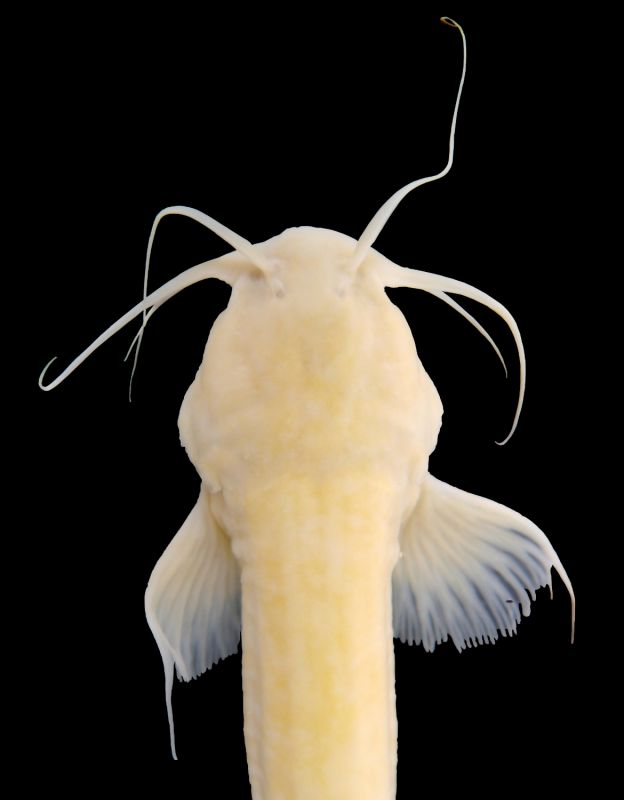Trichomycterus undescribed species 4
[Castellanos-Morales and Galvis 2012]

| ORDER | SUB-ORDER | FAMILY |
|---|---|---|
| Siluriformes | Loricarioidei | Trichomycteridae |
Synonyms
None.
Country
ColombiaTypes
This species has not been described as of June 2018 (Casellanos-Morales pers. comm. June 2018) and there are no types.
Distribution
Endemic to the Magdalena System. Possibly restricted to the department of Santander. Note: This species will be described by Castellanos-Morales.
Habitat
No details published.
Systematics
No details published.
Biological Notes
Florez et al. (2020) made a very thorough study of both epigean and hypogean Trichomycterus in the Province of Santander, Colombia. They were keen to understand whether the hypogean populations were derived from a single colonisation, evolution of troglomorphy and then dispersal to the known cave sites, or whether there had been multiple parallel colonisations followed by independent evolution of troglomorphy. Their data were quite clear that it was the second of these possibilities that had occurred and that some cave populations are very closely related to epigean ones.
Figure 2 of Florez et al. (2020) shows the relationships of all sampled Trichomycterus, and some other, taxa. The best supported clades are numbered 1-3 and hypogean Trichomycterus are found only in clades 1 and 2. Unnumbered clades received lower support and are not relevant here as they contain no troglomorphic taxa. Clade 1 consists of only the troglomorphic T. rosablanca and the widespread epigean species Eremophilus mutisii. Clade 2 is bigger and considerably more complex with 27 terminal taxa in four groups. Group 1 is monophyletic and consists of only the troglomorphic Trichomycterus undescribed species Guapota (3 terminals). Group 2 consists of two taxa, the non-troglomorphic Trichomycterus undescribed species Guadalupe (5 terminals) and the non-troglomorphic T. latistriatus (1 terminal). Group 3 is monophyletic and complex with 18 terminals. Three taxa are found in this group: T. sandavali (4 terminals), Trichomycterus undescribed species Zapatoca (7 terminals) and the hypogean, though apparently not troglomorphic T. uisae (7 terminals). Group 4 is monophyletic and consist of only the non-troglomorphic Trichomycterus undescribed species Curiti (3 terminals). From this set of data we can see that there are at least an additional two troglomorphic species in the genus that are not yet described, Guapota and Zapatoca. This takes the number of troglobitic species in the country to 12 with 5 currently undescribed. However, the lack of genetic structure in Group 3 strongly suggests that all terminals are very closely related and could be considered as the same species. If this were to be accepted then the formal name would be Trichomycterus sandovali Ardila Rodriguez 2006 and Zapoatoca need not be described.
Conservation Status
[NE]
Museum Holdings
None known.
Key References
- Castellanos-Morales, C.A., Marino-Zamudio, L.L., Guerrero, L. and Maldonado-Ocampo, J. (2011)
- Castellanos-Morales, C.A. and Galvis, F. (2012)
- DoNascimiento C., Herrera-Collazos E.E., Herrera-R G.A., Ortega-Lara A., Villa-Navarro F.A., Usma-Oviedo J.S. and Maldonado-Ocampo J.A. (2017)
- Flórez, J.S., Cadena, C.D., DoNascimiento, C. and Torres, M. (2020)
- Flórez, J.S., Cadena, C.D., Donascimiento, C. and Torres, M. (2021)
| Castellanos-Morales, C.A., Marino-Zamudio, L.L., Guerrero, L. and Maldonado-Ocampo, J. | Journal Article | 2011 | Peces del departamento de Santander, Colombia |
| Castellanos-Morales, C.A. and Galvis, F. | Journal Article | 2012 | Las especies del genero Trichomycterus (Siluriformes: Trichomycteridae) en Colombia |
| DoNascimiento C., Herrera-Collazos E.E., Herrera-R G.A., Ortega-Lara A., Villa-Navarro F.A., Usma-Oviedo J.S. and Maldonado-Ocampo J.A. | Journal Article | 2017 | Checklist of the freshwater fishes of Colombia: a Darwin Core alternative to the updating problem |
| Flórez, J.S., Cadena, C.D., DoNascimiento, C. and Torres, M. | Journal Article | 2020 | Repeated colonization of caves leads to phenotypic convergence in catfishes (Siluriformes: Trichomycterus) at a small geographical scale |
| Flórez, J.S., Cadena, C.D., Donascimiento, C. and Torres, M. | Journal Article | 2021 | Repeated colonization of caves leads to phenotypic convergence in catfishes (Siluriformes: Trichomycterus) at a small geographical scale |
